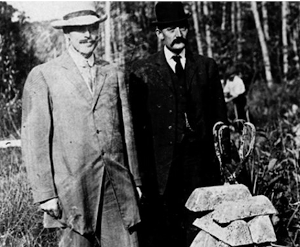1907-09: Life in a Northern League
The GLHA had proven that professional hockey could work despite all the negative publicity the amateur-backing old money suits in Montreal and Toronto could throw at them. This development was obviously of benefit to the players, but as had been shown with professional baseball in the United States, it was also quite profitable for club owners as well. But the GLHA aside, the biggest development in pro hockey's long-term success had very little to do with ice and a whole lot to do with mining. Silver mining to be specific.
In 1903, while the GLHA was still just a dream, silver was discovered in the Lake Temiskaming region of Ontario along the border with Quebec, some 200 or so miles north of Toronto. Over the next few years an amazing quantity of silver was dug out of the earth in this largely unsettled region. Mining made several men wealthy (as they built up mining companies of their own) while drawing many others to the area to work for the aforementioned mining moguls. These working men needed recreation and hockey was a natural choice in an area where winters were both long and cold and the nearest large city was a long trip away. So the various mining towns (which had sprung up around the mines themselves) created their own hockey clubs and just like club owners everywhere, the competition spurred the naturally competitive business owners to seek an edge - and that eventually meant paying top players to come north and play for their clubs.
The genesis of hockey, like that of most other sports, goes back centuries. "Stick and ball" games were common around the world even in ancient cultures. The birthplace of the sport has been claimed by several locales, but the fact is that none of them can prove their claim simply because the game evolved from other, similar games over centuries. Like baseball, the quintessential "American" game, the "Canadian" game's DNA stretches back not only over the North American continent, but also to games common in Europe. Paintings showing early forms of what could reasonably called "hockey" exist going back to the 15th century in European locales such as the Netherlands and England.
What can be reasonably determined is that the current form of the sport was codified in Montreal in the 1870s. Like baseball in the United States, the sport of hockey became "organized" in the bustling second half of the 19th century when societal changes emerging from the Industrial Revolution left the common citizen in need of distractions. And also like baseball, hockey provided a great distraction both from playing the sport and from watching it being played by highly skilled athletes. Naturally, though the sport was promoted in a "gentlemanly" amateur fashion, it was inevitable that professionalism would elbow its way into the sport.

